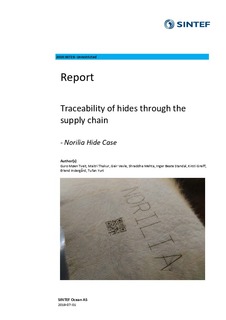Traceability of hides through the supply chain - Norilia Hide Case
Tveit, Guro Møen; Thakur, Maitri; Vevle, Geir; Mehta, Shraddha; Standal, Inger Beate; Greiff, Kirsti; Indergård, Erlend; Yurt, Tufan
Research report
Published version
Permanent lenke
http://hdl.handle.net/11250/2603233Utgivelsesdato
2019-07-02Metadata
Vis full innførselSamlinger
- Publikasjoner fra CRIStin - SINTEF Ocean [1311]
- Rapporter fra SINTEF Ocean [441]
- SINTEF Ocean [1383]
Sammendrag
This study is a part of iProcess project funded by the Research Council of Norway (NFR 255596). The aim of this study was to evaluate various data capture technologies for traceability of hides in a pilot setting. The RFID enabled hide tags provided best readability while there were challenges with the other technologies. RFID tags were used for tracking between the slaughterhouse and Skjeberg. Hides which had dot peening and laser engravings went through the tanning process and the hides returned still had hair on them which made it difficult to read the markings. The UHF and LF RFID tags could not be located in the hides after the tanning process. In theory, all tags and markings tested in the study should be readable, but the tanning process is the main challenge for the available technology. Traceability from the farm to the raw hide processor (Skjeberg) is possible with the technologies available and RFID tags provide promising results. lf the machine-readable requirement is not essential, laser engraving can be used for traceability also including the tanning process.

